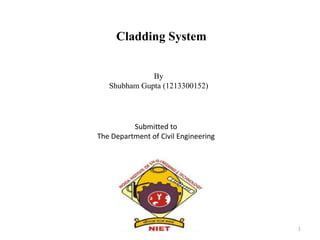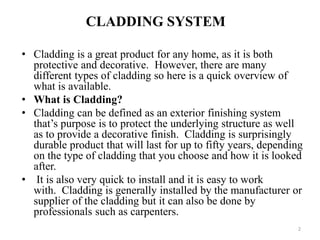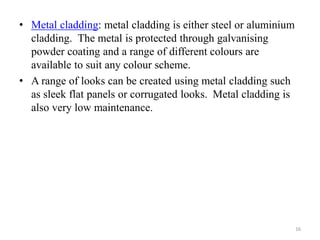Cladding
- 1. Cladding System By Shubham Gupta (1213300152) Submitted to The Department of Civil Engineering 1
- 2. • Cladding is a great product for any home, as it is both protective and decorative. However, there are many different types of cladding so here is a quick overview of what is available. • What is Cladding? • Cladding can be defined as an exterior finishing system that’s purpose is to protect the underlying structure as well as to provide a decorative finish. Cladding is surprisingly durable product that will last for up to fifty years, depending on the type of cladding that you choose and how it is looked after. • It is also very quick to install and it is easy to work with. Cladding is generally installed by the manufacturer or supplier of the cladding but it can also be done by professionals such as carpenters. CLADDING SYSTEM 2
- 3. • Dry Wall Cladding system provides a means of cladding external and internal walls, quickly and cost effectively with a veneer of genuine clay brick to produce a traditional brick finish to buildings of all types. • This unique state of the art cladding system utilizes thin kiln fired clay brick slip tiles permanently bonded to a patented high impact backer panel. They can be used equally on new build or renovation projects and will provide a finished wall that is an exact visual representation of a totally traditionally built brick wall. DRY WALL CLADDING 3
- 4. 4
- 5. 5
- 6. WET WALL CLADDING • Wet wall cladding basically used in bath room area, where water is used mostly all time. • Hence wet wall cladding is done on bathroom walls, and choose water proof kind of material , like glass , vitrefied tiles etc. 6
- 7. 7
- 8. • There are many different types of cladding that you can choose from so you are sure to find the one that is most suitable for you. • Here is an overview of the most common types of cladding: • Weatherboard cladding: it is made from timber, reconstituted hardwood, fibre cement or vinyl. • Weatherboards can be fixed to all kinds of substrates. Timber and fibre cement weatherboards need periodic maintenance to keep them looking their best while vinyl weatherboards are practically zero maintenance. Types of Cladding 8
- 9. 9
- 10. • Timber cladding: timber cladding is extremely popular as nothing beats the look of real timber, and timber suits all styles of homes. • Timber cladding comes in horizontal boards and panels. • This cladding choice as sustainable timber and it is also a good natural insulator. 10
- 11. 11
- 12. • Stone cladding: stone cladding brings a feel of natural style and elegance to your home and the look is unmatched by any other type of cladding. • It uses thin layers of natural or simulated stone. Stone cladding complements any surrounding. However, stone can be expensive and more labour intensive than other types of cladding 12
- 13. 13
- 14. • External foam cladding: this is also known as an External Insulated Finish System (EIFS) and it is made from expanded polystyrene that has been reinforced with fibreglass mesh and finished with a render. • It comes in panel form, is easy to install, is extremely tough and weather resistant, and is extremely energy efficient. 14
- 15. 15
- 16. • Metal cladding: metal cladding is either steel or aluminium cladding. The metal is protected through galvanising powder coating and a range of different colours are available to suit any colour scheme. • A range of looks can be created using metal cladding such as sleek flat panels or corrugated looks. Metal cladding is also very low maintenance. 16
- 17. 17
- 18. • Concrete cladding: this is a newer type of cladding and it comes in panel or tile form ready for use inside or outside the home. Concrete cladding can create sleek modern looks or you can have the concrete moulded to resemble natural materials such as stone. • You can also cast patterns into the concrete cladding if you wish. Concrete cladding is incredibly strong and durable, and requires little in the way of maintenance. It is also a great insulator 18
- 19. 19
- 20. • Brick cladding: brick cladding is great as you can create a variety of looks and patterns just by using different coloured bricks. • You can also render over them if you choose brick cladding. Bricks are lightweight, easy to work with, a good insulator, and don’t need much maintenance. 20
- 21. 21
- 22. • The major purpose of cladding is to separate the indoor environment of a building from the outdoors in such a way that indoor environmental conditions can be maintained at levels suitable for the building’s intended use. • This translates into a number of separate and diverse functional requirements : Primary Functions of Cladding 22
- 23. Functional Requirements • Keeping Water Out • Preventing Air Leakage • Controlling Light • Controlling the Radiation of Heat • Controlling the Conduction of Heat • Controlling Sound 23
- 24. Thank you! 24























